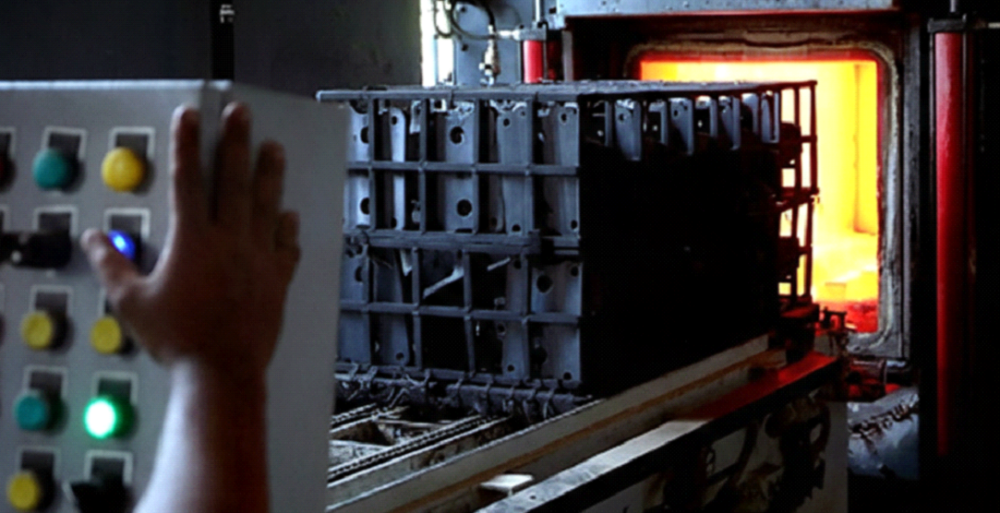
Unlocking the Strength of ADI Parts
Austempered Ductile Iron (ADI) is a unique alloy that undergoes a specialized heat treatment process called austempering, which significantly enhances its strength, toughness, and abrasion resistance compared to other iron and steel parts. ADI is widely used across industries for its superior mechanical performance.
At Bombay Metrics, we leverage the Austempered Ductile Iron process to produce components that deliver exceptional strength, wear resistance, and cost efficiency. Our expertise extends from optimized material selection and process planning to every stage of casting and heat treatment — ensuring consistency and high performance.
Austempering Heat Treatment Cycle

🔥 Austenitizing: The material is heated from room temperature to around 900°C, above the critical temperature. This converts the internal structure into austenite, a high-temperature phase essential for further heat treatment.
💧 Quenching: After reaching the austenitizing temperature, the steel is rapidly cooled to an intermediate temperature of 350°C–300°C. This step avoids direct martensite formation while maintaining structural integrity.
⏳🌡️ Austempering (Isothermal Holding): The steel is held at the chosen austempering temperature for several hours. During this period, austenite transforms into bainite, resulting in superior toughness, strength, and wear resistance.
🌬️ Air Cooling: Finally, the material is air-cooled to room temperature. The resulting microstructure — a combination of bainite and retained austenite — provides remarkable mechanical properties compared to conventional quenching and tempering.
Typical Industrial Applications of ADI
| Industry | Typical ADI Parts | Key Benefits |
|---|---|---|
| ⛏️ Mining | Crusher liners, drill bits | Impact absorption, abrasion resistance, extended liner life |
| 🚗 Automotive | Suspension arms, gears | High strength-to-weight ratio, fuel efficiency, reliability |
| 🌾 Agriculture | Ploughshares, blades | Toughness, resistance to abrasive soils |
| 🚂 Railways | Brake components, couplers | Durability and reliability under high stress |
| ⚙️ Machinery | Chain links, sprockets | Extended operational lifespan |
Key Mechanical Properties of ADI
| Property | Value / Range | Typical Applications |
|---|---|---|
| Tensile Strength | 800 MPa – 1,600 MPa | Automotive suspension arms, crankshafts, railway and construction equipment |
| Yield Strength | 500 MPa – 1,400 MPa | Defence, agricultural machinery, earthmoving, and heavy equipment |
| Hardness | 250 – 500 BHN | Mining, gear & transmission components, hydraulic systems |
| Ductility (Elongation) | 1–10% depending on grade | Automotive safety components, railway couplings, off-highway vehicles |
| Fatigue Strength | 50% higher than conventional ductile iron | Aerospace, automotive drivetrain, industrial machinery |
| Wear Resistance | Transforms locally to martensite under stress | Mining, quarrying, gear and power transmission, oil & gas |
| Strength-to-Weight Ratio | Lighter than steel or aluminum with equal load capacity | Electric vehicles (EV), aerospace, lightweight automotive parts |
Advantages of ADI Parts
- Twice the strength and yield of standard ductile iron.
- Superior abrasion and wear resistance.
- Excellent toughness and fatigue strength.
- More cost-effective than traditional steel or aluminum alloys.
- Retains impact resistance and ductility after heavy use.
- Ideal for complex, near-net-shape castings that reduce machining needs.
Bombay Metrics’ Strategic Role in the ADI Process
- Material Selection & Design Collaboration: We work closely with clients to analyze load-bearing, wear, and fatigue requirements. Based on this, we select suitable ductile iron grades and component geometries optimized for ADI processing.
- Controlled Casting & Pre-Processing: Our foundry team maintains strict metallurgical standards to ensure clean, defect-free castings. Pre-processing steps are carried out to eliminate inclusions or irregularities that could impact heat treatment.
- Post-Casting Operations: After austempering, components undergo secondary treatments, machining, and multi-stage inspections to meet international quality standards.
- Rigorous Quality Control & Testing: We conduct metallurgical analysis, microstructure evaluation, hardness checks, tensile tests, and dimensional inspections at every stage to ensure consistent strength, fatigue resistance, and durability.
- Continuous Improvement & Innovation: At Bombay Metrics, we continually refine the ADI process through R&D, process optimization, and material characterization — expanding its use across renewable energy, railways, and heavy machinery sectors.
“At Bombay Metrics, we are committed to delivering precision-engineered solutions using advanced processes like ADI. Our focus on quality, efficiency, and innovation ensures that we meet the evolving demands of global industries with excellence.”



